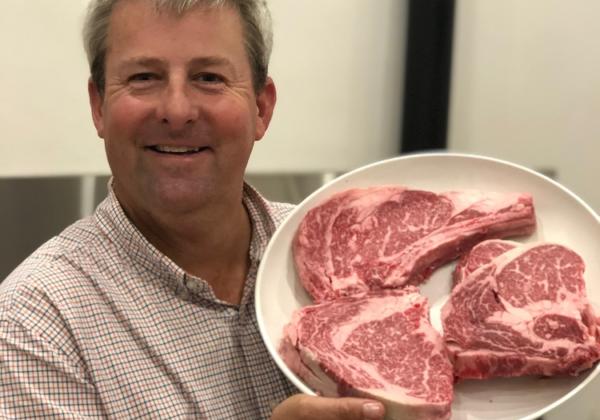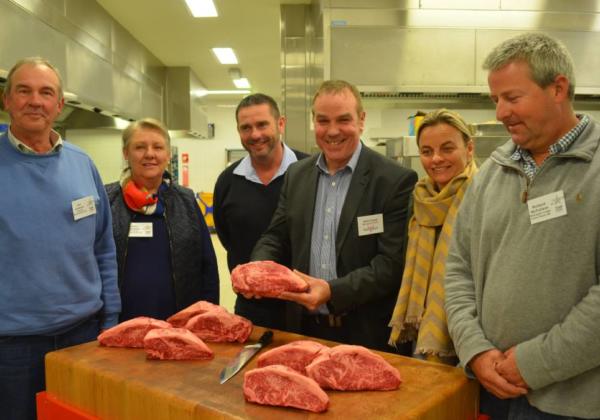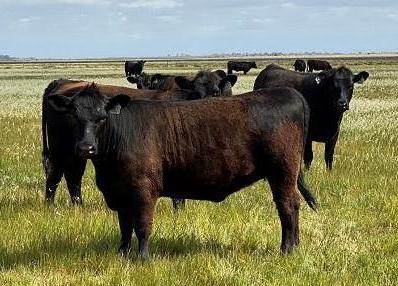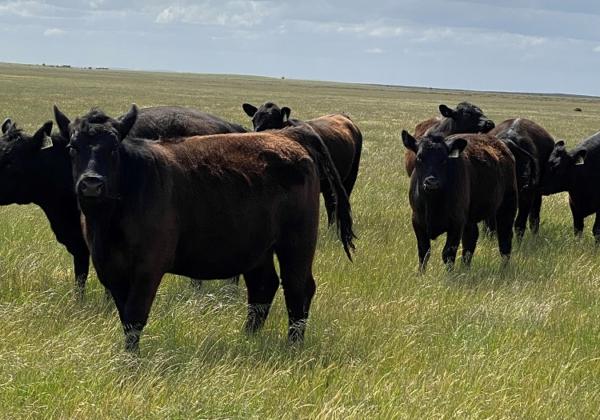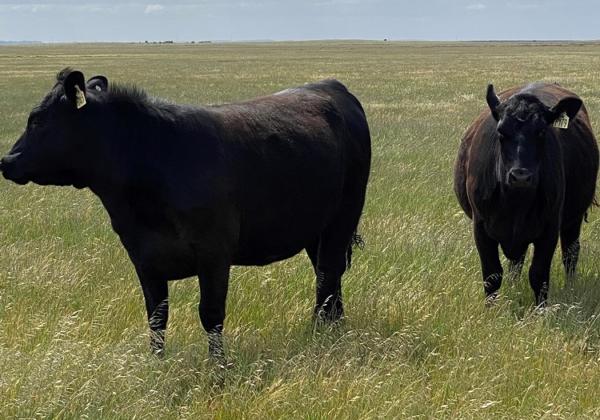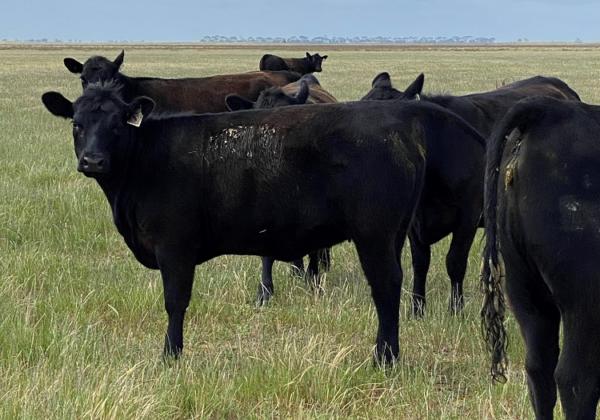Wellington Lodge Changes A Grazing Attitude
Story by Alisha Fogden, Stock Journal 25 May 2019
AFTER generations of hard work cropping and grazing, Wellington Lodge owners Richard and Emma McFarlane are returning to nature to reduce the workload and improve profits.
It is an approach that has allowed the couple to cut inputs used on their farm near Tailem Bend to almost zero and retain their 600-Breeder (or 1300-head) Angus herd through the dry years without buying in feed.
“Other than drenching and fuel, we do not use any inputs,” Mr McFarlane said.
The change came in 2010 after the millennium drought broke.
“We were working flat out cropping, and breeding sheep and cattle for very little reward,” Mr McFarlane said.
“We weren’t making enough money to justify working this way – arming wasn’t fun any more and we could see the country was on the decline.”
They also had the desire to buy part of neighbouring Jockwar Station, to increase their 5,000-hectare holding another 2,600ha.
“But when we did the figures to crop it, we couldn’t make it work,” Mr McFarlane said.
“We would go into debt, we would be working even harder and there was so much pressure for everything to go right to pay it off.”
They then considered running trade cattle on it.
“Immediately the figures started to work, the risk came out of it and we bought it,” he said.
“We bought cheap cattle from Perth and the investment paid off pretty quickly.”
Mr McFarlane said the success of the trading operation helped them realise where they were going wrong.
“We were working way too hard, as were our staff, leaving us little time to improve the business,” he said.
“So we got rid of all the sheep and stopped cropping.
“Immediately we saved a lot on fertiliser bills, cut our fuel bills and stopped having to pay bank repayments on big machinery.
“We sold everything off, giving us the cash to set the property up fully for livestock.
“We thought about keeping some machinery to sow pastures and crop hay, but again the figures didn’t really work.
“We also went from four staff to two – myself and one other workman, most of the time.
“Now money is spent on better genetics and a small bit of hay for our bulls.
“That’s the only feed we have bought, because we also now focus on encouraging natural grass and plant growth – making the most of nature and what is already on the property.”
Since 2013, the herd has comprised 50 per cent traders and 50pc breeders, which feed on native grasses and plants, lucerne stands (sown across both properties just prior to the machinery being sold off) and a small irrigation circle of kikuyu.
We have probable profits even in a bad year.
In tough climatic times, the traders are sold and the breeding herd is run across the two properties.
“That’s been the biggest benefit to the way our operation is now designed – we have probable profits even in a bad year,” he said.
“Those 50pc breeders cover costs, so we are not too concerned if faced with another dry season because that side of the operation pays the bills.
“That’s low-risk, fun agriculture that you can plan for.”
In an attempt to get the most out of native grasses and plants on-farm, the McFarlanes priority graze and sabbath paddocks.
The technique requires a paddock to be “hammered” by the herd, which are then moved to another paddock or two, but then returned to that paddock once plants have returned to “toe height” to again graze.
“How quickly you return to the priority grazed paddock depends on how quickly the grass grow back, which can change through the course of the year/season and rainfall,” Mr McFarlane said.
This hammering ensures the plants “stay greener for longer”.
“Instead of letting a plant grow and grow, out to seed, we try to extend the growth life of the plants and increase the action of the root system underneath the soil,” Mr McFarlane said.
“And depending on the plants we want to thrive, will depend on how long we graze for and then how long we rest the paddock between each grazing. Meanwhile, another paddock will be in Sabbath and not grazed for 12 months.
“This continues until the season closes, generally October, when the green grass goes.
“Once the season closes, we can then calculate how much grass we have left until the season opens again, generally June 1, and then we know if the herd will make it through or not.”
Mr McFarlane said the grazing program also doesn’t follow a pattern, making it different to cell grazing and set stocking.
“We are trying to effect change, particularly in the behaviour of plants, so we make sure we are doing something different in each paddock every year,” he said.
Mr McFarlane said the new grazing approach has resulted in the prolific return of native grass and plant species, such as spear grass, wallaby grass, and blackhead grass.
“We have also managed to keep groundcover through the drought, which keeps the soils cooler, keeps the microorganisms alive in the hot spells, and reduces sand drift,” he said.
They also still benefit from lucerne stands that are up to 25 years old.
“When the lucerne is in sabbath, it has a chance to seed. Livestock also spread the seed, so there’s always new plants coming up.”
There are weed issues, such as horehound, false caper and galvanised burr, but Mr McFarlane says they “come and go”.
“We used to try and cable the burr out, but (that made it worse),” he said.
“But it is moving. One paddock is bad and then it’s not. Then the next paddock is bad and then it’s not, so I’m not too worried, it’s doing a job.
“I’d really love to get rid of it, but the cost isn’t worth it.
“We also used to do everything and anything to get rid of ryegrass, spray three times and think we’d get a good kill, but it always came back.
“That was another trigger that made us want to graze, because we could grow ryegrass like it was going out of fashion.
“The funny thing is, we can’t grow ryegrass like we used to, because it thrives on minimal topsoil.
“Our deeper topsoils have increased plant competition and ryegrass is not as prolific.”
Mr McFarlane said plants were designed to improve the soil and once their job was done, they make themselves extinct, paving the way for a better plant to come along.
“We see that happen all the time,” he said.
“We once had paddocks riddled with horehound and false caper – and now those paddocks have very minimal incursions, like the galvanised burr – this encourages us that we’re on the right path.”
Smaller herds run to protect paddocks
WHILE the rest of the country has struggled through drought, the McFarlanes have been able to retain groundcover and green in their paddocks on very minimal rain.
This has meant no supplementary feeding for their 1300-head Angus herd.
Their traders had to be sold though, which went in September.
“We would have had to start culling our breeders off too, but thankfully it rained this month,” Mr McFarlane said.
“Our breeders are precious to us, but if we keep running them they would damage the soil quite quickly and we believe soil is more valuable and harder to replace than anything else on-farm.”
The breeding herd is split into three matings of 200 head.
“We mate three times a year, so there isn’t 600 (cows and calves) coming through the yards at one time,” Mr McFarlane said.
“The 200-head lots are easier for one person to manage.”
The cows are artificially inseminated and then followed up with bulls.
This is one part of the operation where Mr McFarlane says there is room for improvement.
“We need to record which bull went to which cow, which means paddocks are set stocked for 4.5 weeks – not ideal grazing,” he said.
Mr McFarlane hopes new technologies like virtual fencing and cheaper DNA testing will allow them to improve grazing practices at joining.
The calves are weaned at seven months, after putting on about a kilogram a day.
The weaners are strip grazed on a small irrigated kikuyu paddock for about a month before being put out with the rest of the herd.
Of the young stock, about 150 replacement heifers are kept, drafted by their heavy grain index Estimated Breeding Value, and then joined to Team Te Mania genetics using AI.
“Of those heifers, the lowest index was 140, when the breed average is 119, which is not bad for a commercial herd,” he said.
The rest of the heifers are sold unjoined to other breeders, while the steers are sent to NSW long-fed feedlot Rangers Valley, which values their high marbling potential.
“They like our Team Te Mania bloodlines,” Mr McFarlane said.
“We use data to improve our genetics all the time.
“Since being in Team Te Mania, we have more than quadrupled our average marbling EBV from +0.7 to +3.2, while the breed average is +1.7.
“This has not dropped off in recent tough years and our cattle look very healthy considering the season.”
- Episode 32 of RawAg podcast with Richard McFarlane
- Breedplan recorded, Angus Commercial Register
- Johne’s Status – Beef Only
- CattleCare Accredited
- Calving period – Mar, Jun, Sep

